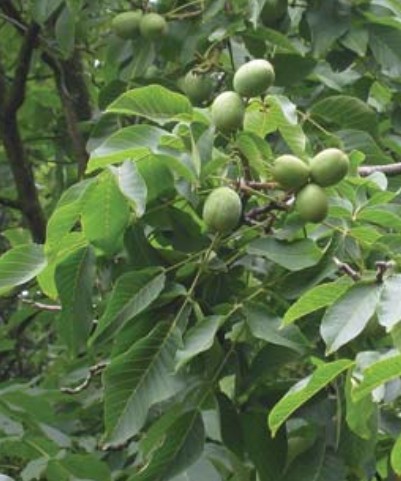Description of a Walnut Tree
When the tree is young the bark is smooth and a greenish brown in colour, eventually becoming covered with diamond-like fissures and turning grey as the tree ages. These trees also have a broad crown, although, if grown in a woodland, then the crown will be that much narrower due to lack of space. The trunk is generally short.
The leaves are long, green, shiny and feathery and then start to turn yellow in the autumn and drop.
Walnuts flower in the spring and have both male and female flowers on the same tree. The male flowers, which appear as drooping catkins, are a yellowish green in colour while the female flowers are shorter and spiky in appearance. The flowers are pollinated by the wind.
The fruit develops once the female flowers have been pollinated and is encased by a grooved and furrowed hard brown shell.
Cultivation of a Walnut Tree
Walnut trees, although able to tolerate most types of soil, prefer a soil that is moisture retaining, fertile and not too sandy or clay-like and needs full sun.
If you are planning on planting a walnut tree, then one less than 10ft tall will be the easiest to establish but make sure the specimen you purchase has not become pot bound.
Avoid planting on any exposed sites or areas with frost pockets as a spring frost or high winds may cause damage to flowers and foliage and an autumn or winter planting is best as this will help the tree establish itself.
Staking will be necessary for the newly planted tree and they will also need plenty of watering during any dry spells during the spring or summer months. To help in retaining moisture add mulch around the base of the tree of some well-rotted compost.
Propagation can be by grafting or seed and although propagation from cuttings is possible, due to poor rooting, it would prove tough to do.
Pests and Diseases
Although walnut trees are generally free from most diseases and parasites the grey squirrel can ruin a whole crop, the codling moth can cause damage to the nuts and walnut blight can have an effect on the leaves.
Pruning of a Walnut Tree
Walnut trees tend not to need regularly pruning but if any dead or crossed branches do need removing this should only be carried out from the middle of summer to early autumn, as walnut trees are susceptible to bleeding.
Hard pruning is not tolerated by walnut trees and no more than 20 percent of the crown should be removed at any one time.
Medicinal Uses
The leaves, oil and fruits of the walnut tree are apparently used in the treatment of diarrhoea, perspiration, tapeworms, hypothyroidism, various skin conditions such as psoriasis and eczema, chilblains and sore throats to name just some!
Other Uses of the Walnut Tree
Due to its colour, wavy grain and durability the timber is highly prized and is used for making cabinets, tables and chairs, floors, caskets, music boxes, panels, veneers and musical instruments.
Walnut shells are even utilized in the production of plastics and glue and the face powder I use, corn silk, even contains ground walnut powder to leave a smooth finish and absorb oil - the best non-clogging face powder I have ever used and I have been doing so for the last 25 years!
Interesting Facts
The Native Americans once extracted the soil from the walnut tree for cooking their beans and corn.
Due to its very many attributes, making it worthy of the Gods, the walnut was called "The Nut of Jupiter" by the ancient Greeks.
Thanks for taking the time to read our article. if you would like more great articles about trees, tree surgery or anything to do with gardening please visit our blog. You may also be interested in the history of oak trees in Richmond Park and other similar articles.






